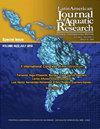Extracts of Moringa oleifera and Croton californicus against infections of Vibrio parahaemolyticus (IPNGS16) in juvenile Pacific white shrimp (Penaeus vannamei)
IF 0.8
4区 农林科学
Q3 FISHERIES
Latin American Journal of Aquatic Research
Pub Date : 2022-08-31
DOI:10.3856/vol50-issue4-fulltext-2825
引用次数: 0
Abstract
We evaluated the inhibition activity of extracts from two common plants, moringa (Moringa oleifera) and croton (Croton californicus), against Vibrio parahaemolyticus (IPNGS16), which causes acute hepatopancreatic necrosis disease (AHPND). The experiment was developed in three phases. First, extracts were prepared, and phytochemical screening of plants was performed. Second, microbiological tests were applied to calculate the minimum inhibitory concentration (MIC). Finally, two bioassays were performed on juvenile shrimp by administering the extracts (first) in shrimp feed at 24 and 72 h, pre-infection, and the second in feed and directly to the culture water. Based on preliminary results of antimicrobial activity, an extract concentration of 60 mg mL-1 inhibited V. parahaemolyticus (IPNGS16) at a final concentration of approximately 1×106 CFU mL-1. Bioassays were carried out in order to determine the V. parahaemolyticus (IPNGS16) median lethal dose (LC50) for juvenile Penaeus vannamei (0.20 ± 0.05 g); the LC50 was 85×103 CFU mL-1. As a first test, the extracts were added to commercial feed at doses of 20, 40, and 60 mg mL-1. After feeding, the shrimp were infected with V. parahaemolyticus (IPNGS16), and mortality was recorded. For the first infection time (24 h), survival was 46 and 33% with croton and moringa, respectively; for the second infection time (72 h), survival was 16 and 25% with croton and moringa. Application of antibacterial extracts directly to culture water were effective against V. parahaemolyticus (IPNGS16). The best result (94% survival) was obtained with a high dose (3.6 mg mL-1 or 30%) of moringa extracts added directly to culture water. Moringa methanol extracts produce active compounds capable of inhibiting replication of V. parahaemolyticus (IPNGS16) in shrimp aquaculture and reducing shrimp mortality.辣木和巴豆提取物对南美对虾幼虾副溶血性弧菌(IPNGS16)的抑制作用
我们评估了两种常见植物辣木(moringa oleifera)和巴豆(croton californicus)提取物对引起急性肝胰腺坏死病(AHPND)的副溶血性弧菌(IPNGS16)的抑制活性。实验分三个阶段进行。首先,制备提取物,进行植物化学筛选。其次,采用微生物学试验计算最低抑菌浓度(MIC)。最后,对幼虾进行了两次生物测定,第一次是在感染前24和72 h将提取物添加到虾饲料中,第二次是在饲料中直接添加到培养水中。根据抗菌活性的初步结果,60 mg mL-1提取物对副溶血性弧菌(IPNGS16)的抑制作用最终浓度约为1×106 CFU mL-1。采用生物测定法测定凡纳滨对虾幼虾副溶血性弧菌(IPNGS16)中位致死量(LC50)(0.20±0.05 g);LC50为85×103 CFU mL-1。作为第一次试验,将提取物以20、40和60 mg mL-1的剂量添加到商品饲料中。饲养后感染副溶血性弧菌(IPNGS16),记录死亡情况。第一次感染时(24 h),巴豆和辣木的存活率分别为46%和33%;第二次感染(72 h),巴豆和辣木的存活率分别为16%和25%。抗菌提取物直接应用于培养水中对副溶血性弧菌(IPNGS16)有较好的抑制作用。高剂量(3.6 mg mL-1或30%)辣木提取物直接添加到培养水中获得最佳结果(94%存活率)。辣木甲醇提取物可产生抑制副溶血性弧菌(IPNGS16)在对虾养殖中的复制和降低对虾死亡率的活性化合物。
本文章由计算机程序翻译,如有差异,请以英文原文为准。
求助全文
约1分钟内获得全文
求助全文
来源期刊

Latin American Journal of Aquatic Research
FISHERIES-MARINE & FRESHWATER BIOLOGY
CiteScore
1.70
自引率
10.00%
发文量
44
审稿时长
4-8 weeks
期刊介绍:
Latin American Journal of Aquatic Research- LAJAR is the continuation of the journal Investigaciones Marinas (1970-2007) and is published since 2008 by the Escuela de Ciencias del Mar, Facultad de Ciencias del Mar y Geografía of the Pontificia Universidad Católica de Valparaíso. LAJAR is an “Open Access” journal that publishes in English language, original research articles, reviews and short communications on aquatic science, which contain the results of research conducted in aquaculture or in oceanic and coastal marine waters of Latin America.
The following topics are considered: Physical Oceanography, Chemical Oceanography, Marine Biogeochemistry, Marine Pollution and Toxicology, Marine Geology and Geophysics, Biological Oceanography, Fisheries and Aquaculture.
 求助内容:
求助内容: 应助结果提醒方式:
应助结果提醒方式:


